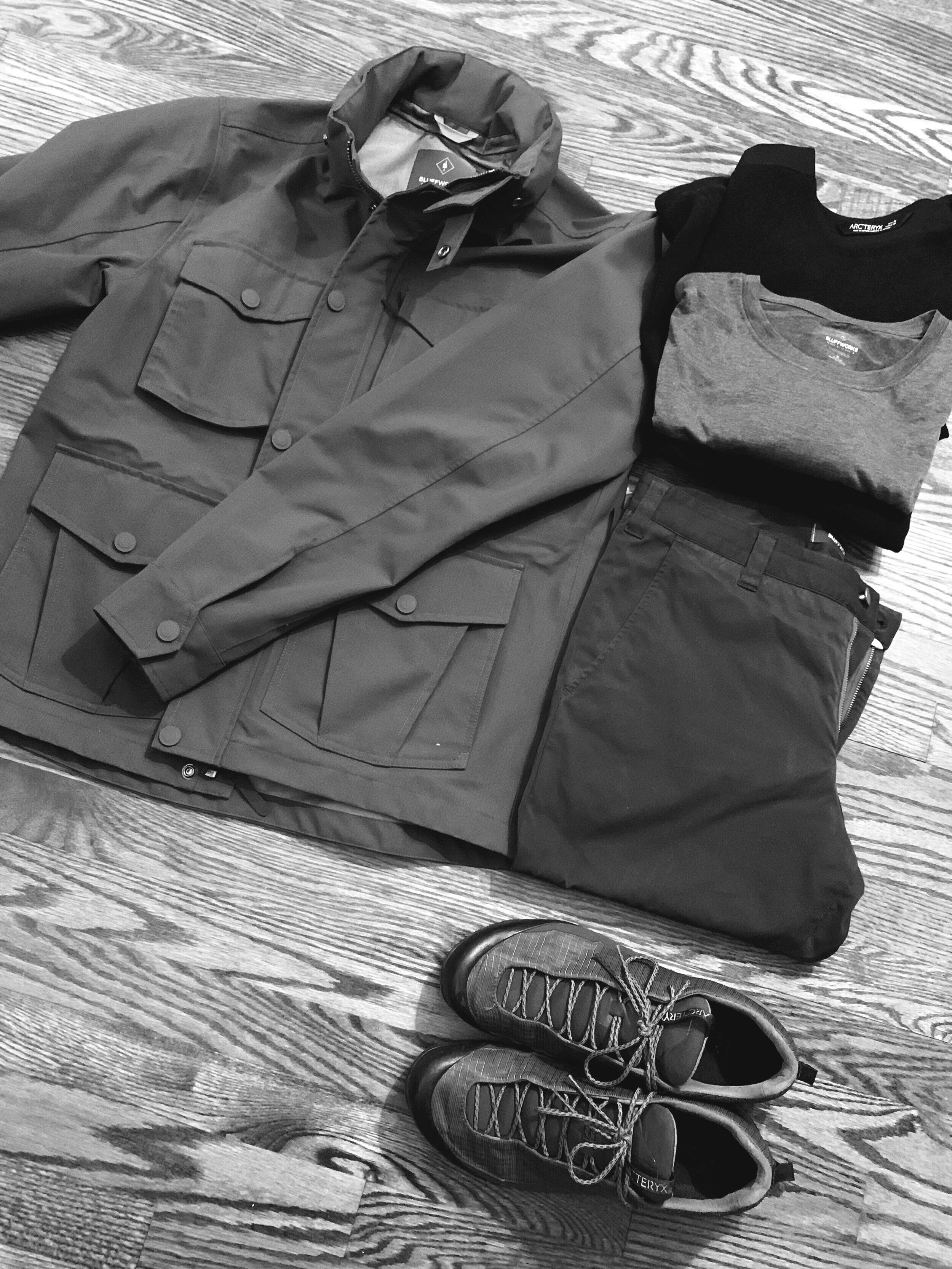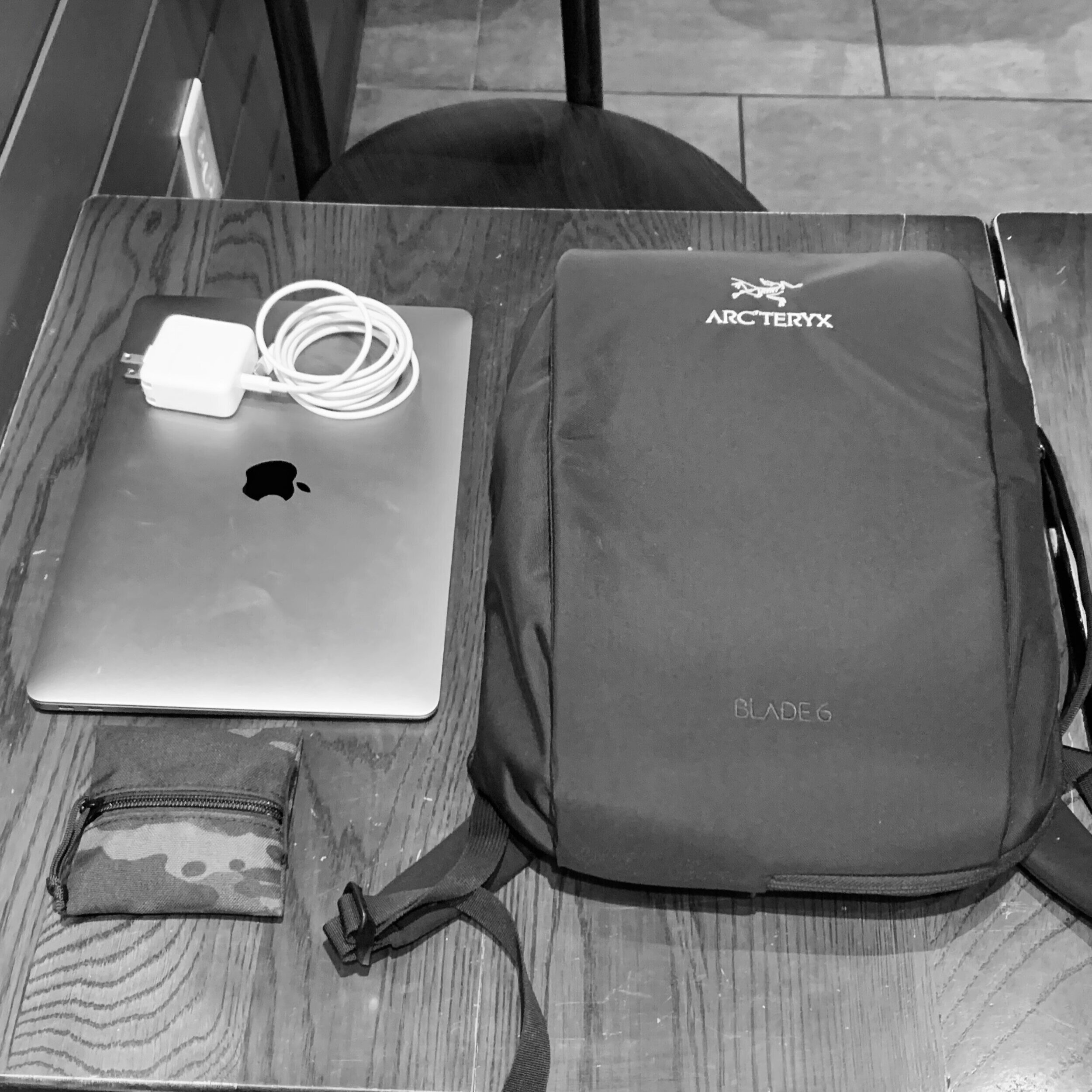Light is Right
So, we’ve talked about techwear and layering. These two things help push out the philosophy of going light forward. The simpler and lighter you make your attire and what you carry while traveling or commuting, the easier it is to move freely and to adapt to the urban environment.
Light is right. Going light allows you to move easily and fast. This, in turn, translates to less stress. It is a simple concept, but one that people don’t put enough time researching and getting right. If you invest in understanding layering, you can make conscious choices about what you wear, and how these items protect you from the elements, but also how they enable you to move and remain nimble. Take for example the items below:

- Bluffworks Field Jacket
- Arc’teryx Donovan Pullover
- Bluffworks Tshirt
- Bluffworks Chino
- Arc’teryx Konseal FL Shoes
These items can be layered for a great Fall experience. The tshirt can be worn as a base layer, and it’s stylish enough to wear in the office (techie style), the pullover is heavy enough to provide warmth, without overheating, the jacket provides wind and rain resistance, and extra warmth. Remove some layer when it’s warmer, and add it when it’s colder. All items are lightweight, breath right, and provide the right level of mobility.
The thing is, the more you move in a city, the more you realize that it’s all about remaining low key, being able to manage the weather, and thrive in the chaos of the city. In order to do this, you have to learn to remain light, to bring only the necessary stuff, while at the same time be able to have enough wiggle room in those times when the weather turns, or when the indoor is greatly different than the outdoor.
For this to work correctly, you have to develop not only the knowledge of your environment, but create a system of clothing + carry items that works to support this. The lighter you can be, the easier you’ll be able to move. And the easier you can adapt to changes in weather or other conditions, the better and less stressful your commute will be.
Light is right.
Take Half of What You Think You Need and Put It Away
If you are looking for a way to begin thinking “light”, focus on this: the bigger the backpack you carry, the more you will be tempted to pack and carry more. Add to this the simple truth that more often than not, at least half of what you thought is useful, is not.
If you stop one second and think about these two points you’ll come to the realization that it’s about paying attention. You will sometimes need to carry more, or have space for the “unexpected”, but I bet if you begin to write down every day what you carry with you, and what you actually used from what you carry, you’ll notice quickly that at least half of what you carry is never used.
How do you select the item to carry then?
That is a good question. In my case, it was a few years of commuting and iterating on what I thought was good to get to what I carry today. It was a process, an experiment, and a few times I found myself needing something I didn’t have. But, you adapt.
Try a few combinations. Go out everyday and notice what is missing, or what is extra. Take notes. Look at the details of your commute and ask yourself: do I really need all these items? What would happen if I didn’t have them?As I mentioned in Philosophy: a key point to making the commute easier, is being comfortable
It’s About the Fabrics Too
Part of being agile, able to move freely, and remain cool/dry/warm, is the fabrics of what you wear and carry as well. As I mentioned in the Philosophy, a key point to making the commute easier is being comfortable. Comfort removes a lot of the stress from the commute. Being warm when it’s cold, being dry when it rains, or being comfortable standing when the trains are crowded (maybe soon they will be again), for example, will lessen some of the hassles of everyday commuting.
I make it a point to always find the lightest possible item that I need and can afford. And yes, sometimes it’s going to be an investment, but I realize it is a good one.
Think “Speed is Safety”. And speed comes from being able to move freely. Do you really need that heavy trench coat? Can you find an alternative that looks as good, but it’s made from lightweight technical fabrics?
Mindset is Key
At the end of the day it is about how comfortable you can be with little. It might seem a bit stressful, especially when traveling, but the benefits of going light are huge. Try it. Put the might in the right place. It’s all mental.
It’s all on how we approach the problem.
"It's how you approach a situation that will determine the outcome."
Develop the mindset by learning, trying, practices, and looping on what work and what doesn't. Once you have this, and you have to develop not only the knowledge of your environment, but you have created a system of clothing + carry items that works to support this, you'll be in the position to focus on other parts of the commute. The lighter you can be, the easier you’ll be able to move.
Closing
The thing about packing and being light is that you can very easily decide to work in a coffee shop for an hour or two, pack everything and move to a park bench, if the weather is nice, or just take a break and go somewhere.
If you learn to only bring what you need, very quickly you’ll realize that you can get a ton of work done, commute better and be safer.
Here's an example:

Working on the road is better when you carry the essentials. I don’t think it can be lighter than this, well, I suppose I could only bring a laptop... In the picture:
- Laptop and charger
- Small pouch with entry kit, AirPods, USB drives and iPhone charger.
- 6L Arc’teryx Blade 6 pack
Experiment with the gear you bring. Understand your needs. Understand what works and what doesn’t. Seek the lightest possible system of clothing and the things you carry.